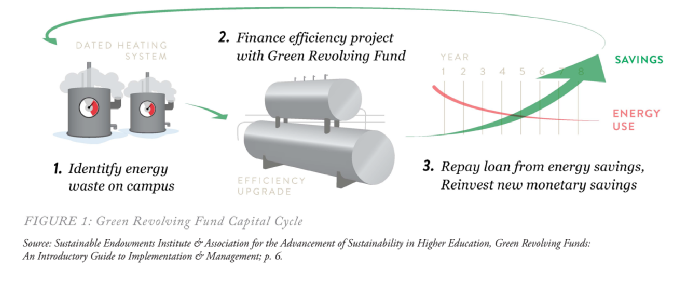Conservation and Efficiency Revolving Fund
Note: CERF is no long active at UW. This page serves as a reference to CERF as an example of UW’s and the CSC’s energy efficiency work in previous years.
The University of Wyoming (UW) has successfully developed the Conservation & Efficiency Revolving Fund (CERF) with $250,000 in seed capital from UW Physical Plant. The Campus Sustainability Committee has been integral to the development of the fund, with additional support provided by multiple academic stakeholders including the School of Energy Resources (SER), College of Business, Haub School of Environment and Natural Resources, and College of Agriculture and Natural Resources. The specifics of implementation are as follows:
WHY
Revolving funds such as the CERF are successfully established at many institutions of higher education across the country in order to fund efficiency, conservation, and sustainability projects. After establishing seed capital, funds are dedicated to select energy, water, and waste infrastructure and behavior projects. These projects present an excellent return on investment—an average of 28% has been demonstrated at other institutions. Financial savings are tracked, quantified, and returned to the fund to support future projects. Rather than an expenditure, the CERF will serve as an investment in UW that will benefit the university by:
-
reducing operating expenses;
-
providing a living-laboratory for student engagement and applied research;
-
improving the built environment;
-
reducing exposure to energy price fluctuations;
-
improving the sustainability perception of prospective students and alumni, making us more competitive with peer institutions;
-
reducing greenhouse gas emissions per our President’s Climate Commitment obligations;
-
providing examples of innovative efficiency measures for implementation throughout the state

WHAT
Initial funding of $250,000 provided by Physical Plant will be used to launch the fund. The first project to be implemented through the CERF will be an internally identified campus-wide final laboratory air filter replacement scalable to fit the budget provided by the fund. The project is conservatively estimated to have a payback period of just 3.6 years and provides the added benefit of reducing future maintenance needs, setting a precedent for the type of smart projects the CERF will continue to enable.
A variety of projects with quick payback periods and high returns on investment, such as lighting retrofits and building retro-commissioning, have been identified as potential future projects. Additional funding through external sources such as grants and donors will be sought to grow the fund to at least $1 million over the next 6 years in order to support additional projects.
Student involvement in the CERF will initially be limited to assistance with implementation and tracking to allow for thorough fund development. Once the fund process is established, the Campus Sustainability Committee (CSC) will sponsor an ongoing proposal process to solicit individual, organization, and course-based student projects, beginning in Fall 2014.
WHERE
The CERF will be hosted by Physical Plant, which has the technical expertise to implement and track fund projects, while welcoming collaboration with academic stakeholders to ensure student engagement in campus as a living laboratory. Although the fund will be located in Physical Plant, a multi-stakeholder committee based in the CSC will administer the fund.
HOW
To safeguard the ability of Physical Plant to pay utility obligations, energy savings will be conservatively estimated with final project approval lying with the Physical Plant. Such estimation will be aided by membership in the Billion Dollar Green Challenge, providing access to resources such as best practices and the Green Revolving Investment Tracking System (GRITS). Membership funding of ~$500/year will be provided by the College of Business. In addition to student involvement in the initial CERF development, the Department of Management and Marketing has allocated time and resources for a graduate assistant to serve as an appointed student CERF coordinator within the CSC to assist with fund implementation, management, and research. The College of Agriculture and Natural Resources has additionally allocated 10% of the energy extension coordinator’s time to CERF implementation in 2014. The multi-stakeholder CERF committee will further support implementation needs.
WHEN
Critical CERF implementation steps occured at the following dates:
-
February 28, 2014: Joined the national Billion Dollar Green Challenge to commit to the fund
-
March 30, 2014: Formalized by-laws, proposal process, and multi-stakeholder review committee
-
April 22, 2014: Announced the CERF to the campus community in conjunction with Earth Day
-
Fall semester 2014: Opened project proposal process to students, staff, and faculty.
RESOURCES
The Billion Dollar Green Challenge (greenbillion.org) and the Association for the Advancement of Sustainability in Higher Education (AASHE) resources will be heavily utilized throughout the initial launch of the fund. Green
Revolving Funds: A Guide to Implementation and Management, updated in July 2013, provides
an established framework for fund development.
